|
|
|
|
|
|
|
Achi-Kochi Japan
Showing many places to visit and foods to eat in Japan
|
|
|
|
|
|
|
|
|
|
|
|
|
Japan
> Themes
> Local Specialty Dishes
|
|
|
|
|
|
|
Local Specialty Dishes
( Achi-Kochi Japan )
|
|
|
|
|
|
|
|
|
|
|
|
|
( "Achi-Kochi" in Japanese means "Here and there" in English. )
Local Specialty Dishes
Though most of areas of Japan have a humid subtropical climate, there are some areas which belong to the subarctic zone. There are some islands which have a tropical rainforest climate as well as there are some islands which have an oceanic climate.
Though Japan is surrounded by the sea, there are some prefectures surrounded by mountains without facing the sea. So tourists could enjoy various local specialty dishes in many areas in Japan.
This page shows Local Specialty Dishes except Noodles and Seafood.
As for Noodles ==> Noodles
As for Seafood ==> Seafood
|
Robata-Yaki BBQ

"Robata-Yaki", a Japanese style BBQ cooked on a charcoal grill in front ot customers, originated in Kushiro City located in the east of Hokkaido, where some restaurants serve Robata-Yaki BBQ, looked after by the staff as above, though there are some restaurants where customers cook on a grill by themselves. ( The elderly woman in the above photo has looked after Robata-Yaki BBQ for longer than half a century in a restaurant named "Robata".)
Kushiro City has a significant commercial fishing port so there are lots of fresh seafood suitable for Robata-Yaki BBQ such as Karei ( flounder ), Shishamo ( shishamo smelt ), Sake ( salmon ), Hokke ( atka mackerel ), Hokki ( sakhalin surf clam ) and so on. Also meats and vegetables are nice for Robata-Yaki as well.
|
Imoni

The above photo, taken in a restaurant located near Yamadera, Yamagata Prefecture, Tohoku Region, shows "Imoni". Imoni is one of local specialty dishes popular in Yamagata Prefecture. It is a dish cooked in a pot with shoyu ( soy sauce ) or miso paste in some areas, sake and sugar. Its ingrediants are satoimo ( taros ), beef ( pork in some areas ), konjac, spring onions, burdocks, various mushrooms and so on.
In autumn, people in the prefecture enjoy traditional Imoni party on the riverbed. In September, a big Imoni Festival is held in Yamagata City, for which 30,000 portions of Imoni are prepared in a large hot pot whose diameter is several meters. Not only local people but also tourists could join the festival on first-come-first-served basis. Some restaurants in the area serve Imoni as well.
|
Miso Dengaku

Tasty Miso ( soybean paste ) is produced in Aizu Wakamatsu City and its surrounding areas, Fukushima Prefecture, Tohoku Region. So tourists could enjoy eating tasty Miso Dengaku ( above ) in the city. Miso Dengaku is food skewered with Miso and chargrilled as above. Its ingredients are satoimo ( taro ), tofu, rice cake, potato, mashrooms, seasonal vegetables and so on.
The above photo was taken in "Mitsuta-ya" a restaurant and miso shop, established in the early 19th century. At the time, Aizu Wakamatsu was the capital city of the feudal domain. Even now, the city is called " Samurai City", where many tourists visit Tsuru-ga-jo Castle, Japanese gardens, Japanese Tea House and so on.
|
Natto
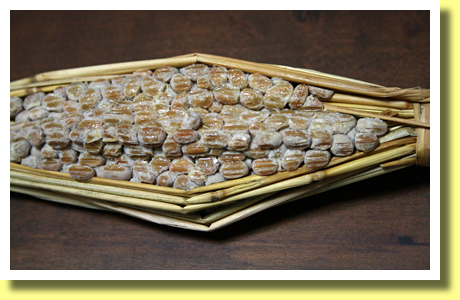
Mito is the capital city of Natto, much more than the capital city of Ibaraki Prefecture, Kanto Region. While Natto is sold now in small polystyrene containers here and there throughout Japan, Natto sold in rice straw ( above ) could be easily found in Mito City and its surrounding areas as decades ago. Traditionally Natto was made from boiled soybeans fermented in rice straw which provides soybeans with Natto-Kin bacterium ( Bacillus aubtilis ).
In Mito, tourists could find many shops selling various kinds of Natto. Also there tourists could find numbers of restaurants serving various kinds of Natto dishes such as Natto and sashimi, Natto spring roll, Natto dumplings, Natto tempura, Natto with sardine, Natto omelette, Natto kama-meshi and many more. It is worth staying in Mito not only to visit Kairakuen gardens and historical sites but also to enjoy eating various Natto dishes.
|
Monja-yaki

There is everything in Tokyo, such as various kinds of Japanese cuisine as well as European, Asian, African and North/Sonth American cuisine. However Monja-yaki ( above ) is one of famous and popular local specialty dishes served in Tokyo as well as Hiroshima and Osaka are famoous for Okonomi-yaki. There are many restaurants serving Monja-yaki especially in Tsukishima District in Tokyo.
Monja-yaki is pan-fried batter of wheat flour mixed with sauce and dashi broth. Before pan-fried, some ingredients, such as meat, cheese, cabbage, rice cake, sakura shrimp, mentaiko ( walleye pollack roe ) and so on, are mixed into batter. Compared with Okonomi-yaki, batter of Monja-yaki is almost liquid and runnier. Ingredients of Monja-yaki are chopped up into pieces smaller than those of Okonomi-yaki.
|
Shima-zushi
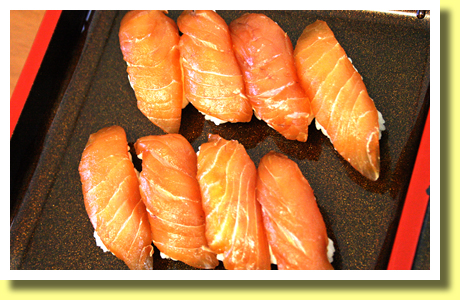
There are some restaurants serving Shima-zushi ( island sushi - above ) in some subtropical islands such as the Ogasawara Islands ( the Bonin Islands ) which belong to Tokyo Metropolis. Shimazushi, local to such islands, is a unique variation of sushi, topped with pickled slices of fishes using not wasabi ( Japanese horseradish ) but karashi ( Japanese mustard ) as a condiment.
In such islands, frequently bad weather disturbed islanders catch fresh fishes. Also people had no refregerator decades ago. So fresh fishes were dried, salted or pickled to keep. In addition, it was difficult for the islanders to obtain wasabi in the past. So Shima-zushi was created there. Though there are now many restaurants serving ordinary sushi topped with slices of fresh fishes and wasabi in such islands, Shima-zushi is served in some restaurants and popular among tourists.
|
Basashi
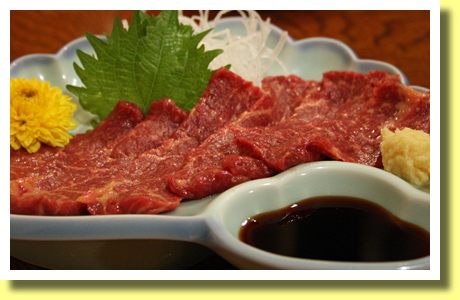
Not throughout Japan but in some prefectures such as Nagano, Koh-Shin-Etsu Region and Kumamoto, Kyushu Region, people love Basashi and there are many restaurant serving Basahi in such prefectures. Basashi ( above ) is horse meat sashimi. They eat Basashi dipped in shoyu ( soy sauce ) with grated garlic, grated ginger or wasabi ( Japanese horseradish ).
Also there are restaurants serving sushi topped with slices of raw horse meat. In addition, many serve horse meat not raw but cooked such as Yakiniku ( Japanese-style BBQ ).
|
Tebasaki

Tebasaki ( deep-fried chicken wingtip - above ) was originated in Nagoya City, Aichi Prefecture, Tokai Region. After deep-fried, Tebasaki wingtips are basted with sauce, seasoned with salt and pepper.
People living in Nagoya love Tebasaki so much and there are many restaurants serving Tebasaki in the city. Nowadays Tebasaki is so popular throughout Japan and tourists could have opportunities to eat Tebasaki anywhere in Japan.
|
Goheimochi
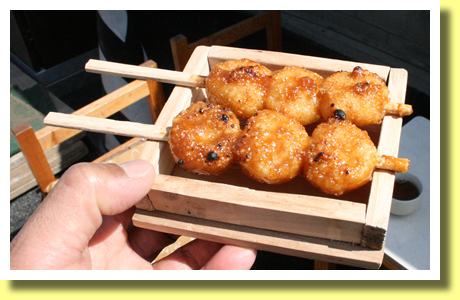
Goheimochi ( above ) has been and is popular in mountains in Tokai and Koh-Shin-Etsu Regions for a few hundred years. Goheimochi is rice dumplings on skewers, seasoned with sauce made from sesame ( or walnuts/peanuts ), mirin ( sweet sake ), and miso ( soybean paste ), then grilled.
The above photo was taken in Inuyama City, Aichi Prefecture. The city has developed as a castle town since the late 15th century and lots of people visit the city to see the famous Inuyama-jo Castle.
|
Kushi-katsu

Kushi-katsu ( above ) was originated in Shin-sekai district, Osaka City, Osaka Prefecture, Kinki Region. Kushi-katsu is deep-fried skewered foods such as beef, pork, chicken, squid, prawn, octpus, shiitake mushroom, onion, pumpkin, ginger and so on. Not only in Shin-sekai district but also throughout Osaka City, there are many restaurants serving Kushi-katsu.
Before eating Kushi-katsu, most of the people dip it in a sauce. The sauce pots are shared among customers and double dipping in the sauce is far from expected.
|
Shojin Ryori
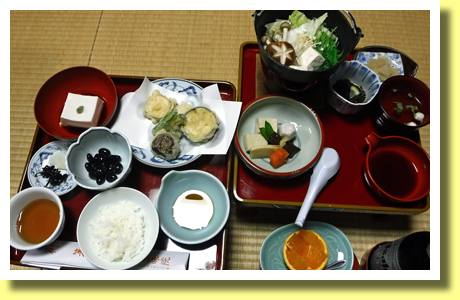
The above photo shows Shojin Ryori served in Kongo-Sanmai-in, a Buddhist temple located in the precinct of Koya-san Kongobu-ji Temple Complex, Wakayama Prefecture, Kinki Region.
Shojin Ryori looks gorgeous. Yes, it is and all the dishes are delicious.
Various kinds of dishes were served and various kinds of ingredients were used such as tofu ( soybean curd ), goma-dofu ( sesame seed curd ), shiitake mushroom, seaweed, black soybeans, runner beans, shimeji mushroom, Chinese cabbage, boiled rice and many more. However no meat nor fish was found. Traditionally and typically, no meat nor fish be used in Shojin Ryori.
Since the 13th century in Japan Shojin Ryori had developed as Buddhist cuisine and Buddhism had not expected animals to be killed. So no meat nor fish has been used in Shojin Ryori. There are some temples and some restaurants serving Shojin Ryori all over Japan. However it is said that some restaurants use fish in Shojin Ryori, such as Katsuo-bushi ( shaved pieces of dried bonito ) in Dashi broth.
|
Okonomi-yaki
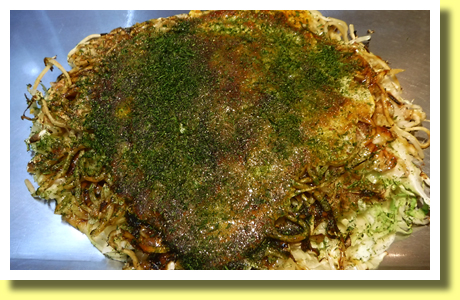
They say that Okonomi-yaki ( above ) is the soul food of Hiroshima. Hiroshima is so famous for Okonomi-yaki as well as Osaka is. It is said that there are a few thousands of Okonomi-yaki restaurants in and around Hiroshima City, Hiroshima Prefecture, Chugoku Region.
In Hiroshima, Okonomi-yaki is thin flour dough cooked on an iron plate with layers of various ingredients such as sliced pork, shrimps, squids, egg, cabbage and/or noodles, topped with Okonomi-yaki sauce and seaweed flakes. In Osaka, dough and ingredients are mixed and cooked without layers. Both styles are popular in Japan.
|
Awa-odori chicken
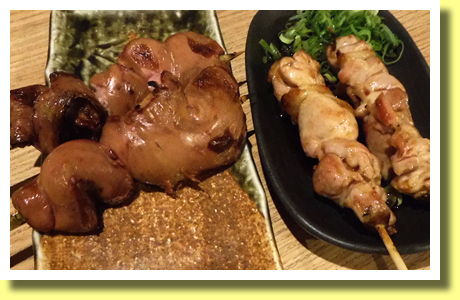
Tourists would find some restaurants and bars who serve Awa-odori Yakitori ( broiled chicken on skewers - above ) in Tokushima City, Tokushima Prefecture, Shikoku Region. Awa-odori is a variety of Jidori chicken bred in the prefecture. Its low fat and rich chewy meat is very popular. Its meat is so nice not only for yakitori but also in other chicken dishes including hot-pots.
|
Sobagome Zosui
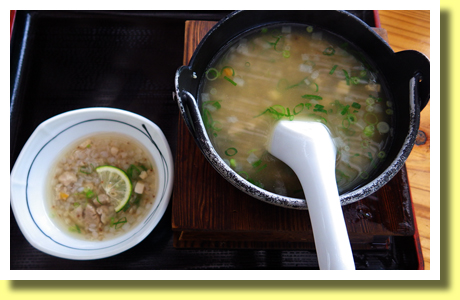
Sobagome Zosui ( above ) is one of local specialty dishes served in Iya Valley, Tokushima Pref., Shikoku Region. Soba ( buckwheat ) is one of the main staples in the valley. " Sobagome " means buckwheat seeds, boiled in salted water and dried without grinding, while " Zosui " means porridge. So " Sobagome zosui "( above ) is buckwheat porridge, which is unique to Iya Valley.
|
Jigoku Mushi Dishes
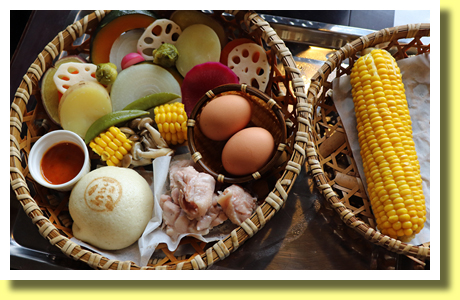
In Beppu Onsen, Beppu City, Oita Prefecture, Kyushu Region, eight million tourists enjoy natural onsen hot springs every year. Also many tourists enjoy Jigoku Mushi Dishes ( above ), which are various ingredients ( pork, chicken, seafood, eggs, vegetables and so on ) cooked with high temperature steam of natural hot springs.
There in Beppu are some facilities where tourists could cook with steam by themselves, while there are some restaurants serving Jigoku Mushi Dishes. Jigoku Mushi "Purin" ( pudding ), creme caramel flan cooked with the steam is also popular among tourists.
|
Takachiho Beef

Takachiho Town, Miyazaki Prefecture, Kyushu Region, is famous for one of the highest-quality Wagyu brands, Takachiho Beef. The above photo shows a sirloin steak of Takachiho Beef served in Restaurant "Nagomi" in the town. The restaurant, operated by a local organization of JA ( Japanese Agricultural Cooperatives ), is one of the best to enjoy Takachiho Beef and serve not only steaks but also Yakiniku ( Japanese BBQ ), hamburg steak, rice bowl topped with Takachiho Beef.
Also Takachiho Town is famous as a town of Japanese mythology. Tourists could enjoy watching Kagura ( Shito Ritual Dance ) showing some of Japanese myths in the town.
|
Copyright (c) 2023 Achi-Kochi Zanmai Co., Ltd.
|